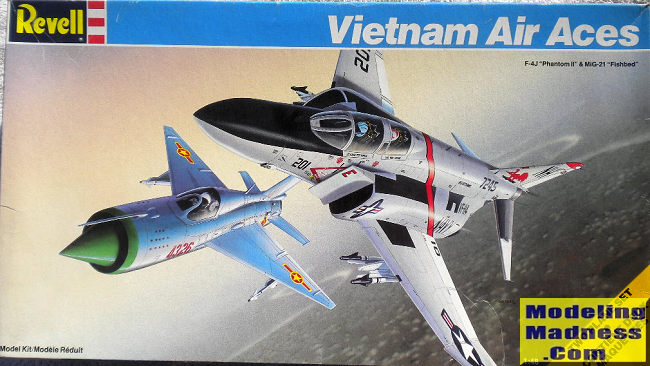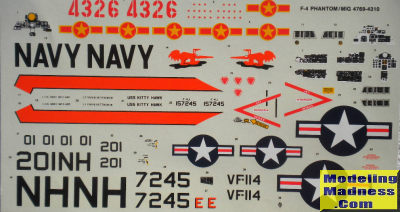
| KIT #: | 4769 |
| PRICE: | $ |
| DECALS: | Two options (one per kit) |
| REVIEWER: | Rick Reinbott |
| NOTES: |
MiG-21 “Fishbed”—72 parts on 4 sprues, 1 clear sprue with 2 parts F-4J “Phantom II”—94 parts on 4 sprues, 1 clear sprue with 7 parts |

| HISTORY |
One of the world’s greatest ever combat aircrafts, the two-seat Phantom II was designed to meet a U.S. Navy requirement for a fleet defense fighter to replace the F3H demon and counter the threat from long-range Soviet bombers. When the F-4 proved faster than the F-104 Starfighter, the U.S. Air Force ordered the Phantom II as well. The F-4 was first used by the U.S. Navy as an interceptor but was soon employed by the U.S. Marine Corps (USMC) in the ground support role. Its outstanding versatility made it the first U.S. multiservice aircraft flying concurrently with the U.S. Air Force, Navy and Marine Corps. The Phantom excelled in air superiority, close air support, interception, air defense suppression, long-range strike, fleet defense, attack and reconnaissance. The F-4J was the follow-on aircraft to the Navy’s F-4B and incorporated many of the systems and structural changes found in Air Force Phantoms. The landing gear was beefed up and the wider tires found on Air Force Phantoms were used, which meant that the upper and lower wings had the characterestic “bulge” found on Air Force F-4s. A slotted stabilator was incorporated on production F-4Js, which reduced the landing speed by almost 12 knots. The latest electronic ger was installed, including the all-new AN/AWG-10 missle control and radar system. ECM equipment such as the AN/APR-32 RHAW system was installed with the antennas being mounted in the fairing on top of the fin and under the nose. Other changes included the Martin-Baker Mk. 7 ejection seats with the “zero-zero” feature, the addition of a #7 fuel cell, and a pair of uprated J79-GE-10 engines, each with 17,900 lbs. of thrust.
The MiG-21 was originally designed as a short-range, high-performance fighter.
Because of its hard-hitting armament and simple cost-effectiveness, it became
the most widely used fighter aircraft in the world. Experiences from the
air war over Korea influenced the design of the delta-winged MiG-21, which was
developed from a series of prototypes that flew in the mid-1950s. 1960 saw
the development of the MiG-21 PF with a redesigned nose to accommodate the new
R1L radar in a moveable conical centerbody in the middle of the nose air intake.
This model also introduced the more powerful R-11F2-300 engine for improved
performance.
| THE KIT |
MiG-21 “Fishbed” kit
 Upon
opening the separate bag, you’re presented with 4 sprues of silver-colored
parts. The kit represents the PF version of the MiG-21. There is some flash
present, more so on the smaller parts. Two types of tails are provided, one
being the broad cord and the other the narrow cord. There are ejector pin marks
on most parts, although they are kept inside. The cockpit parts consist of a
tub, ejection seat (poorly molded), instrument panel (clear), and control stick.
The ejection seat contains some seat harness detail. There are decals for the
instrument panel and console dials. No sidewall detail is provided. The panel
lines are of the raised variety and, considering the age of the kit, look okay.
No pilot figure is included.
Upon
opening the separate bag, you’re presented with 4 sprues of silver-colored
parts. The kit represents the PF version of the MiG-21. There is some flash
present, more so on the smaller parts. Two types of tails are provided, one
being the broad cord and the other the narrow cord. There are ejector pin marks
on most parts, although they are kept inside. The cockpit parts consist of a
tub, ejection seat (poorly molded), instrument panel (clear), and control stick.
The ejection seat contains some seat harness detail. There are decals for the
instrument panel and console dials. No sidewall detail is provided. The panel
lines are of the raised variety and, considering the age of the kit, look okay.
No pilot figure is included.
There is no detail on the inner gear doors or inner surface of the speed brake, and there is no wheel well for the nose gear, with the nose wheel itself being glued to a hole in the fuselage. Some ribbing detail is present in the main landing gear wells on the fuselage, although those wells on the wings are devoid of detail. The speed brake well contains some detail. The missle pylons are devoid of detail and contain some ejector pin marks as well. Two K-13 (NATO AA-2 Atoll) air-to-air missles are included but are rather plain, although the centerline drop tank is nicely detailed. The landing gear is acceptable, but the tires contain no tread detail. The engine section consists of the afterburner injector rings over the turbine face attached directly to the afterburner nozzle. The clear, one-piece canopy is a somewhat thick but not too bad overall.
F-4J “Phantom II” kit
 Upon
opening the separate bag, you’re presented with 4 sprues of gray-colored parts.
Flash is present on a number of parts. The cockpit parts consist of a tub,
ejection seats (poorly molded), instrument panels (clear) and control sticks.
The bottom half of the ejection seats, molded as part of the cockpit tub,
contain some seat harness detail. There are decals for the instrument panel and
console dials, yet the F-4J does not have consoles for the rear cockpit. The
instrument panels for the front and rear cockpits have different shapes, and the
decals provided for them look reasonably accurate compared with an actual F-4J.
No sidewall detail is provided. There are ejector pin marks on the landing gear,
gear doors, missle rails and AIM-9 sidewinder missles. The AIM-7 sparrow missles
are in two halves. Neither set of missles contains any detail. No fuel tanks are
included. The panel lines are of the raised variety and, considering the age of
the kit, look okay.
No pilot figures are included.
Upon
opening the separate bag, you’re presented with 4 sprues of gray-colored parts.
Flash is present on a number of parts. The cockpit parts consist of a tub,
ejection seats (poorly molded), instrument panels (clear) and control sticks.
The bottom half of the ejection seats, molded as part of the cockpit tub,
contain some seat harness detail. There are decals for the instrument panel and
console dials, yet the F-4J does not have consoles for the rear cockpit. The
instrument panels for the front and rear cockpits have different shapes, and the
decals provided for them look reasonably accurate compared with an actual F-4J.
No sidewall detail is provided. There are ejector pin marks on the landing gear,
gear doors, missle rails and AIM-9 sidewinder missles. The AIM-7 sparrow missles
are in two halves. Neither set of missles contains any detail. No fuel tanks are
included. The panel lines are of the raised variety and, considering the age of
the kit, look okay.
No pilot figures are included.
The general shape of the fuselage and wings look accurate. Each intake contains separate front parts and intake plates. There are ejector pin marks on the interior of the front intake parts. Two separate noses are included, one for an F-4E and one for this F-4J model. The upper and lower wings and main wheel covers contain the bulges for the thicker tires of the F-4J; however, the main tires themselves do not appear to be the thicker type. No tread detail is present on any of the tires. The nose and main landing gear are finely detailed. There are no ECM fairings on the intakes, indicating that the model represents an early F-4J. The kit contains slotted stabilizers. The wing pylons provided have the curved leading edge type of Air Force F-4s rather than the straight leading edges of Navy and Marine Phantoms. The three small actuater fairings (parts 48 and 49), which would normally go under each wing on a slatted aircraft, should not be used, and the locator holes should be filled and sanded smooth. The afterburner nozzles appear to be of the longer type, but there is no interior plate containing any afterburner detail. There are separate windscreen and canopy parts, so the canopy can be displayed open or closed. Clear pieces are also provided for the side windows between each cockpit.
 The
instructions are well laid out and provide color call-outs along with a painting
chart for each aircraft and a decal placement guide. A short, well-written
history of each aircraft is also provided. The decals arr thick and glossy and
provide markings for the following aircraft:
The
instructions are well laid out and provide color call-outs along with a painting
chart for each aircraft and a decal placement guide. A short, well-written
history of each aircraft is also provided. The decals arr thick and glossy and
provide markings for the following aircraft:
MiG-21 PF “Fishbed,” #4326, Vietnamese Peoples’s Air Force
F-4J “Phantom II,” #7245, LCDR Pete Pettigrew and Lt. JG Mike McCabe, VF-114, USS Kitty Hawk, May 1972
| CONCLUSIONS |
Both kits have been around for awhile, with the MiG-21’s most recent boxing being Revell kit #5482. The F-4’s most recent boxing may be this one, with a release of 1987. Although obviously not up to the standards of modern kits, it doesn’t look like they’ll present too many challenges in building and should look nice on your shelves when completed.
| REFERENCES |
F-4 Phantom II in action—Aircraft No. 65, Larry Davis, Squadron/Signal Publications 1984.
F-4 Phantom II in Detail & Scale, Vol. 12, USN & USMC versions, Part 3, Bert Kinzey, Aero Publisher, Inc. 1983.
A Handbook of Fighter Aircraft, Francis Crosby, Anness Publishing Limited 2002.
February 2019
Copyright ModelingMadness.com Thanks to
for the review kit. You can find this one at your favorite hobby shop
or on-line retailer. If you would like your product reviewed fairly and fairly quickly, please
contact
the editor or see other details in the
Note to
Contributors. Back to the Main Page
Back to the Review
Index Page
Back to the Previews Index Page